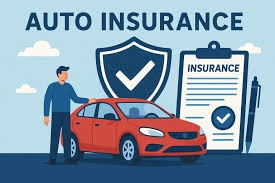Understanding Car Insurance: A Complete Guide for Every Driver

- Understanding Car Insurance: A Complete Guide for Every Driver
- Why Car Insurance Is More Than Just a Legal Requirement
- 1. What Is Car Insurance and Why You Need It
- 2. How Car Insurance Works: Premiums, Deductibles, and Coverage
- 3. Types of Car Insurance Policies Explained
- 4. How to Choose the Best Car Insurance for Your Vehicle
- 5. Common Myths About Car Insurance
- 6. The Future of Car Insurance: Technology, AI, and Safer Roads
Why Car Insurance Is More Than Just a Legal Requirement
Imagine this: you’re driving home after a long day, music playing, when suddenly—BAM!—an unexpected collision happens. Your first thought? “How much is this going to cost me?” Without car insurance, that single accident could drain your savings in an instant.
Car insurance isn’t just another monthly bill. It’s a financial shield, a safety net that protects both your vehicle and your peace of mind. Whether it’s a fender bender or a major accident, having proper coverage means you’re not facing those costs alone.
1. What Is Car Insurance and Why You Need It
Car insurance is a contract between you and an insurance company. You agree to pay a premium, and in return, the insurer helps cover costs if your car is damaged, stolen, or involved in an accident.
In most countries, car insurance isn’t optional—it’s the law. But beyond legal compliance, it’s about financial protection. Accidents can lead to thousands of dollars in damages, medical bills, or even lawsuits. Insurance ensures that one bad day doesn’t ruin your financial future.
Having car insurance also provides emotional security. Knowing that your expenses will be covered in case of an accident gives you confidence behind the wheel. It’s not just about protecting your car—it’s about protecting yourself, your passengers, and everyone else on the road.
2. How Car Insurance Works: Premiums, Deductibles, and Coverage
To truly understand car insurance, you need to know how the financial side operates.
-
Premium: The amount you pay regularly (monthly or yearly) to maintain your policy.
-
Deductible: The amount you pay out of pocket before the insurer covers the rest.
-
Coverage Limit: The maximum amount your insurer will pay for a claim.
Here’s a simple example: if your deductible is $500 and repairs cost $2,500, you pay $500, and your insurer pays the remaining $2,000.
Insurance companies calculate premiums based on factors such as:
-
Your age and driving history
-
Type of car and its value
-
Location (urban vs. rural areas)
-
Credit score (in some countries)
Drivers with safe records and low-risk vehicles usually pay less. Meanwhile, sports car owners or new drivers may face higher premiums.
Understanding these terms helps you make smarter choices when selecting or adjusting your policy.
3. Types of Car Insurance Policies Explained
There are several types of car insurance, and knowing the difference can save you money while ensuring proper protection:
-
Liability Coverage: Covers damages or injuries you cause to others. This is usually mandatory.
-
Collision Coverage: Pays for repairs to your car after an accident, regardless of who was at fault.
-
Comprehensive Coverage: Protects against non-collision events like theft, fire, vandalism, or natural disasters.
-
Personal Injury Protection (PIP): Covers medical expenses for you and your passengers after an accident.
-
Uninsured/Underinsured Motorist Coverage: Protects you if you’re hit by someone who doesn’t have enough insurance.
Choosing the right mix depends on your budget, car value, and risk tolerance. For instance, if your car is new or financed, collision and comprehensive coverage are essential. But for older cars, liability-only coverage might make more sense financially.
4. How to Choose the Best Car Insurance for Your Vehicle
Finding the best policy doesn’t have to be overwhelming. Here’s a step-by-step approach:
-
Evaluate your needs: Consider your vehicle’s age, value, and how often you drive.
-
Compare quotes: Don’t settle for the first offer—use comparison websites to get multiple quotes.
-
Check discounts: Many companies offer discounts for safe driving, bundling home and auto insurance, or installing anti-theft devices.
-
Review coverage limits: Make sure your policy covers both property damage and medical costs adequately.
-
Read customer reviews: Service quality and claim response speed are just as important as cost.
Pro tip: Always read the fine print. Some policies have exclusions that could surprise you later—like not covering floods or certain repairs.
A good car insurance policy strikes a balance between affordability and comprehensive protection. Paying slightly more for reliable coverage can save you thousands in the long run.
5. Common Myths About Car Insurance
Let’s bust some common misconceptions about car insurance:
-
Myth 1: Red cars cost more to insure.
Color doesn’t matter—your premium is based on the car model, value, and your driving record. -
Myth 2: Older drivers always pay more.
Actually, experience often means lower premiums, unless there are recent accidents or violations. -
Myth 3: My personal car insurance covers business use.
Not necessarily. You’ll likely need commercial auto coverage for business-related driving. -
Myth 4: My insurance will cover everything.
Every policy has limits and exclusions. Always check what’s included before assuming you’re fully protected.
Knowing the truth behind these myths helps you make smarter financial and coverage decisions.
6. The Future of Car Insurance: Technology, AI, and Safer Roads
The car insurance industry is evolving fast. Thanks to technology, insurers can now offer personalized policies based on your actual driving habits.
Here’s what’s shaping the future:
-
Telematics: Devices or apps track your driving behavior (speed, braking, mileage) and reward safe drivers with discounts.
-
AI Claims Processing: Artificial intelligence is speeding up claim approvals, reducing paperwork and delays.
-
Usage-Based Insurance (UBI): “Pay-as-you-drive” models let you pay only for the distance or time you spend driving.
-
Autonomous Vehicles: As self-driving cars become more common, insurance policies will focus more on software and manufacturer liability.
Technology is making car insurance more transparent, fair, and cost-effective. The future looks bright for drivers who embrace innovation.
1. What does car insurance typically cover?
It usually covers vehicle damage, theft, medical bills, and third-party liability depending on the policy type.
2. How can I lower my car insurance premium?
Maintain a clean driving record, increase your deductible, and take advantage of loyalty or multi-policy discounts.
3. Do I need car insurance if I rarely drive?
Yes. Even parked cars can be stolen or damaged, and many countries legally require at least basic coverage.
4. Does car insurance cover rental cars?
Some policies include rental car coverage, but it’s best to confirm before renting a vehicle.
5. What happens if I don’t have car insurance?
You could face hefty fines, license suspension, or legal penalties—plus full financial responsibility for any accident.

